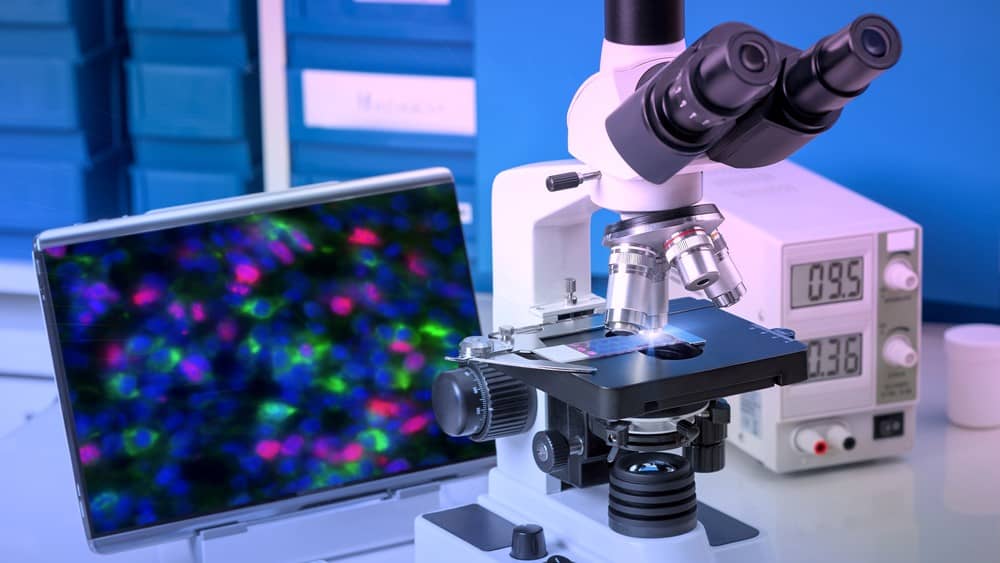Compound light microscopes are the most commonly used imaging devices in the world. They are intensely useful in a wide variety of situations and environments. Often found in classrooms, university laboratories, and small-scale research labs, their practicality is unmatched. It’s easy to see just how useful these tools are when examining them objectively.
Today, we’ll break down how this type of compound microscope works, look at the parts that make them up, and examine their history and various applications. These are extremely common scientific instruments, but many people aren’t entirely sure of their specific uses or even how to use them.
Contents
What Is a Compound Light Microscope?

While the name of a compound light microscope might be a little bit intimidating to people unfamiliar with them, they are fairly simple devices. When referring to whether or not a microscope is “compound,” you just need to look at whether or not they contain a single lens.
Back in the early days of microscopy, a microscope with a single lens was all that was available, but today it is referred to as a simple microscope because of its simple design and the fact that there are so many modern microscopes. By contrast, a compound microscope is one that contains more than one lens.
Now, what about the “light” part of the name? Well, that refers to the imaging part of the compound light microscope, as light is typically projected from the bottom to illuminate the specimen better.
Back in the day, this light could come from any number of sources, including organic sources, candlelight, or even incandescent bulbs. However, these days the light is usually projected from some sort of electronic or fluorescent light to give a soft glow that won’t negatively affect the vision of the microscope user.
Why Are Compound Light Microscopes So Popular?
The biggest reason why compound light microscopes are so popular is because they are inexpensive. Because they require very few parts and can be manufactured relatively cheaply, they can be quickly assembled and shipped out wherever needed.
Compound light microscopes are a building block for most first-world science classrooms because they instantly make much of the world more accessible. Introducing an entire classroom to the wonders of the world surrounding us by having them examine the intricacies present in your average blade of grass can do wonders for visualizing just how interesting science is.
Compound light microscopes are more than just economical in price. The upkeep is minimal and easy to handle when something goes wrong with the lens, the light projection mechanism, or the eyepiece lens. Parts are also relatively easy to replace, even for amateurs.
Another benefit to compound light microscopes is that they are easy to learn how to use. They usually only have a few parts, making their operation reasonably simple, as opposed to more complicated setups, like a scanning electron microscope, phase contrast microscope, or stereo/dissecting microscope. We’ll get into the specific parts that make up your average compound light microscopes in a moment, but generally speaking, there aren’t many.

Parts of a Compound Light Microscope
Your average compound light microscope is only made up of a few parts, which we’ll list before breaking them down by function:
- Eyepiece lens
- Light projection mechanism
- Ocular lens
- Condenser lens
- Objective lens
- Specimen holder
As indicated by its name, the compound light microscope uses multiple lenses to multiply the magnification available to the viewer. The ocular lens is closest to the eye and multiplies the magnification that the objective lens puts out.
In some compound light microscopes, viewers will have access to multiple objective lenses, which gives viewers the ability to cycle through certain magnifications and view specimens in various ways. By cycling through certain levels of magnification, a user can see human hair in a number of different ways.
The light projection mechanism is another essential part of the compound light microscope, giving users high visibility. As we mentioned before, this light source can come from various sources, but the most common these days is a simple electric light source.
Applications of a Compound Light Microscope
Compound light microscopes are helpful because they are highly practical for viewing different things. Unless we’re talking about subatomic particles or highly-sensitive specimens, compound light microscopes can do an excellent job of magnifying almost everything.
The most advanced compound light microscopes can give users up to 2000x magnification. Any average classroom or amateur scientist can get an incredibly accurate representation and breakdown of whatever they’re interested in examining.
Compound light microscopes are found everywhere, from the home of your average geode enthusiast to most university laboratories. Again, unless you’re trying to analyse specific protein molecules or other nano or microparticles, compound light microscopes will do you just fine for the average magnification job.
Better Understanding Compound Light Microscopes
Compound light microscopes are highly useful devices with various uses and applications. We hope this article proved helpful to you and gave you a bit more understanding of how exactly they work and why they’re so popular.
Since they are one of the most popular types of microscopes, it is highly beneficial to understand the basics of how they work when you are diving into how exactly they function. Either way, at Optical Mechanics, we hope this breakdown gave you more insight into how they work.

